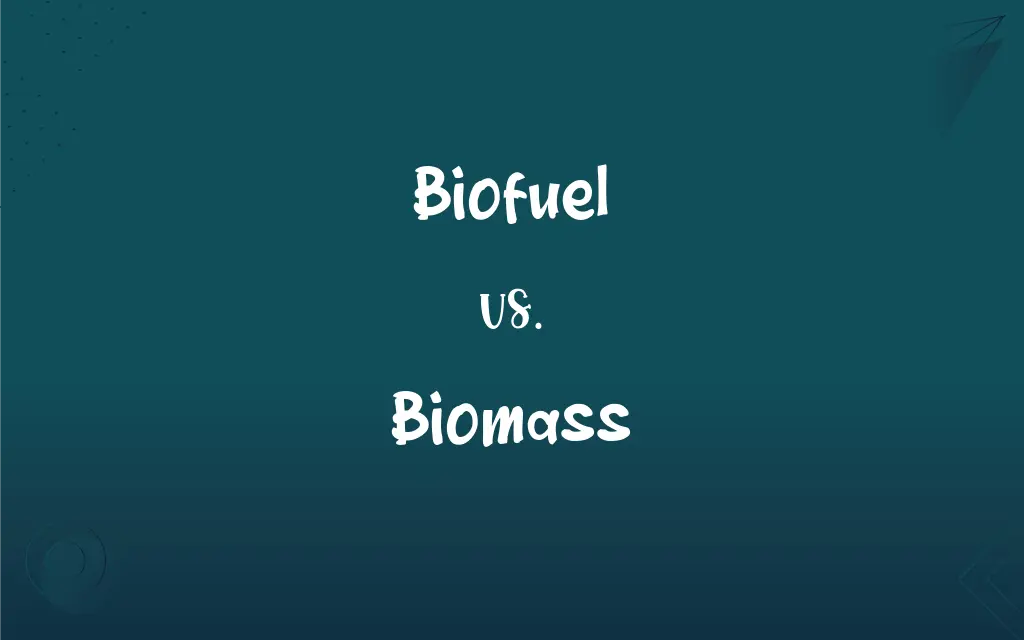Biofuel vs. Biomass: What's the Difference?
Edited by Aimie Carlson || By Harlon Moss || Updated on October 27, 2023
Biofuel is energy derived from living matter; biomass is the organic material used to produce biofuel.

Key Differences
Biofuel is a type of fuel that is directly derived from living or recently living organisms, including plants and animal wastes. On the other hand, biomass refers to the organic matter, whether plant or animal-based, that can be used as a resource to produce such fuels.
While biofuel serves as an alternative energy source to fossil fuels, biomass is the raw material that is processed or converted to obtain these fuels. In essence, biofuel is the product, and biomass is the primary ingredient.
The motivation for using biofuel is to have a renewable, eco-friendly energy source, which can help reduce greenhouse gas emissions. Biomass, as the precursor to biofuel, offers an abundant and versatile source of raw material from various organic origins.
When you fill your car with biodiesel, you're using a type of biofuel derived from biomass sources like vegetable oils or animal fats. Similarly, when ethanol is added to gasoline, it is a biofuel produced from the fermentation of biomass, typically from sugarcane or corn.
The global push towards sustainable energy solutions has accelerated the interest in biofuel production, which inherently relies on the availability and management of biomass sources, such as crop residues, forest waste, and even algae.
ADVERTISEMENT
Comparison Chart
Definition
Fuel made from living organisms
Organic material used to produce fuel
Role
Product or energy source
Raw material or resource
Usage
Alternative to fossil fuels
Feedstock for biofuel production
Examples
Biodiesel, bioethanol
Wood, crop residues, animal manure
Environmental Consideration
Reduces greenhouse gas emissions
Can be sustainably sourced or managed
ADVERTISEMENT
Biofuel and Biomass Definitions
Biofuel
It's an alternative fuel produced from living organisms.
The use of biofuel is seen as a solution to reduce our dependence on fossil fuels.
Biomass
Biomass is the foundation for biofuel production.
Corn and sugarcane are essential biomass for ethanol production.
Biofuel
Biofuel can be liquid, gas, or solid derived from biomass.
Ethanol, a liquid biofuel, is commonly added to gasoline.
Biomass
It refers to plant or animal matter.
Agricultural waste represents a significant amount of available biomass.
Biofuel
Biofuel aims to reduce carbon emissions and environmental impact.
By transitioning to biofuel, cities can significantly lower their carbon footprint.
Biomass
It's a renewable source of energy in its raw form.
Burning wood, a type of biomass, has been a heat source for centuries.
Biofuel
This renewable fuel can be produced from various organic materials.
Algae is being researched as a potential source for biofuel.
Biomass
Biomass consists of organic materials used as energy sources.
The forest's biomass can be converted into usable energy.
Biofuel
Biofuel is energy derived from organic matter.
Cars that run on biofuel contribute less to air pollution.
Biomass
Biomass includes materials like wood, algae, and animal waste.
Researchers are exploring algae biomass for its potential in energy production.
Biofuel
A fuel, such as biogas or biodiesel, that is produced from renewable resources, especially plant biomass, vegetable oils, or treated municipal and industrial wastes.
Biomass
The total mass of living matter within a given unit of environmental area.
Biofuel
Any fuel that is obtained from a renewable biological resource, especially from biomass.
FAQs
Is biofuel considered a renewable energy source?
Yes, biofuel is a renewable energy source because it's derived from current living matter.
What's the role of biomass in biofuel production?
Biomass serves as the raw material or feedstock for producing biofuel.
Can you define biomass?
Biomass refers to organic material, both plant and animal, used as a resource to produce energy.
Why is biofuel considered environmentally friendly?
Biofuel, when burned, releases carbon that was recently captured from the atmosphere, making its carbon footprint potentially lower than fossil fuels.
How is biomass converted to biofuel?
Biomass can be converted to biofuel through various processes, including fermentation, transesterification, and pyrolysis.
What is biofuel made from?
Biofuel is made from living or recently living organisms, often derived from biomass.
Are all types of biomass suitable for biofuel production?
No, while many types of biomass can be used, the efficiency and viability differ based on the biomass source.
What are some common sources of biofuel?
Common sources include ethanol from corn or sugarcane, and biodiesel from vegetable oils.
What are the environmental implications of using biomass?
Sustainable management of biomass resources ensures reduced deforestation and promotes carbon sequestration.
Is biofuel more expensive than traditional fuel?
The cost of biofuel can vary, but advancements and increased production are making it more competitive with traditional fuels.
Are there different types of biofuels?
Yes, there are several types, including bioethanol, biodiesel, and biogas.
How can biofuel help combat climate change?
Biofuel can reduce the reliance on fossil fuels, potentially decreasing greenhouse gas emissions.
Are there any drawbacks to using biomass as an energy source?
Potential drawbacks include land use concerns, competition with food crops, and water usage.
Can biomass and biofuel help in achieving energy security?
Yes, by reducing dependence on imported fossil fuels, they can contribute to energy security.
How does the burning of biomass affect air quality?
While burning biomass releases CO2, it's considered carbon-neutral as the carbon was recently taken from the atmosphere by the plant material.
Can any organic material be considered biomass?
Technically, yes, but not all organic materials are efficient or sustainable for energy production.
Can you grow specific crops for biomass production?
Yes, crops like switchgrass or miscanthus are grown specifically for biofuel production.
Is biofuel production efficient?
Efficiency varies based on the type of biofuel and the process, but ongoing research aims to improve this.
Can biofuel be used in standard engines?
Some biofuels, like certain biodiesels or ethanol blends, can be used in standard engines with little to no modification.
Is the use of biomass for energy ancient or recent?
Ancient; for example, burning wood for heat or cooking is an old form of using biomass for energy.
About Author
Written by
Harlon MossHarlon is a seasoned quality moderator and accomplished content writer for Difference Wiki. An alumnus of the prestigious University of California, he earned his degree in Computer Science. Leveraging his academic background, Harlon brings a meticulous and informed perspective to his work, ensuring content accuracy and excellence.
Edited by
Aimie CarlsonAimie Carlson, holding a master's degree in English literature, is a fervent English language enthusiast. She lends her writing talents to Difference Wiki, a prominent website that specializes in comparisons, offering readers insightful analyses that both captivate and inform.































































